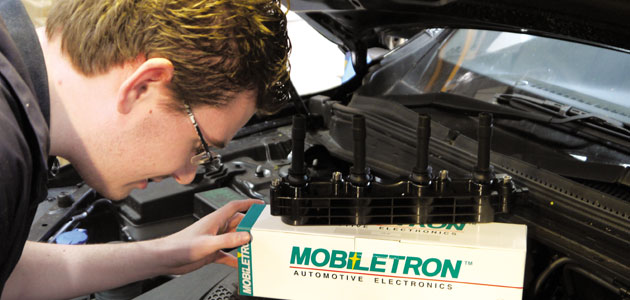
Expert – Mark Astley, Senior Support Engineer, Mobiletron.
Although ignition systems are fairly robust pieces of kit, faults do occur. The primary function of the ignition system is to transform the 12 V from the vehicle battery into over 10,000 V to produce a spark for combustion. A big task for a small component!

Ignition system technology has seen some dramatic changes in development over the years. Early systems comprised of two main elements: the coil and the distributor. The distributor was a mechanically driven switch and spark energy was delivered to the spark plug via high voltage cables. Distributors, however, were an inefficient method of delivering energy due to the reliance on mechanical components. They were also often subjected to damp and wear and tear.
The natural progression was to develop a DIS (distributor-less ignition system) using electronic signals from the engine-management system to trigger the spark. This resulted in much improved efficiency of the ignition system itself, as the energy is delivered directly to the spark plug and is controlled by the ECU. The most recent technological development has resulted in the new pencil coils that we see today. These are a single cylinder ignition unit applied directly to each spark plug and can be removed and serviced/replaced individually. The coils relay to the ECU with ignition current and voltage waveform information, enabling faults to be pinpointed or even identified by the ECU. This reduces service time and overall costs for the customer. Mobiletron’s CE28 is an example of a new generation pencil coil, and has been developed and tested using the latest technology.
All Mobiletron ignition systems are designed and manufactured to improve efficiency of the engine. The products are put through our TQM system, as well as being subjected to our reliability test methodology, to ensure our customers can be confident when fitting any of our components.
HOW TO IDENTIFY THE SOURCE OF THE PROBLEM
■ Failure to start a car by its own means or by jump start could signal an ignition coil pack failure
■ Check the HT leads and coil terminals for damage
■ Check that all bolts are tightened to the correct torque. Ignition coils are grounded through the bolts onto the body of the vehicle; loose bolts can cause poor grounding and this can waste the spark energy
■ An oscilloscope can be used to check signals from the coil pack
■ When pencil or stick coils are used, try swapping the coils from cylinder-to-cylinder to see if the misfire follows the coil pack, indicating a faulty product
COMMON PROBLEMS
■ The vehicle won’t start
■ Difficulty starting in cold or humid conditions – if the spark plugs don’t receive optimal voltage levels from the coil, starting the vehicle will prove difficult
■ Misfiring
■ Decline in fuel efficiency – when one or more spark plugs are not generating enough spark energy the remaining cylinders must compensate for the loss of power, resulting in increased fuel consumption
■ Stalling when idling









